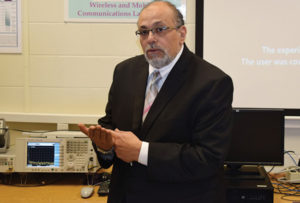University of Bridgeport professor finds new applications for wireless technology
When Khaled Elleithy received the news in January that he was elected as a fellow in the African Academy of Sciences, the Egyptian-born associate vice president for graduate studies and research at the University of Bridgeport appreciated the culmination of a long nomination process.
“Election to be a fellow requires an ability to demonstrate that you have strong research expertise in certain fields, whether it involves technology or engineering or science,” he said. “The process comes from nomination by the current fellows. You have to submit all of your work to show how you have advanced in the field ”” in my case, wireless and mobile communications. Then the nomination is sent to a number of reviewers from the same field around the world, and the board makes a final decision.”

Elleithy is no stranger to being acknowledged by his peers: he is a senior member of the IEEE computer society, the co-founder and co-chairman of the Annual International Joint Conferences on Computer, Information, Systems Sciences, & Engineering, and was a former chairman of the International Conference on Industrial Electronics, Technology & Automation. He also has published more than 350 research papers in national and international journals.
Nonetheless, Elleithy has little time to rest on his laurels. As the director of the university”™s Mobile and Wireless Communications Laboratory, which he founded in 2004, Elleithy and his students are at work on a series of projects that offer significant breakthrough advancements in health and communications. One of the most intriguing projects currently being developed is an epilepsy detection device that could send out signals of an impending seizure to both the individual and to others who could provide treatment during an attack.
“We are looking at the signals just before it occurs,” he explained. “We hope this will create a warning or an alert for a person with epilepsy. If he is standing, he could sit down. If he is driving, he could just pull over.”
Another device being tested at the laboratory would provide digital input for the visually impaired to help them navigate around obstacles in their path. The prototype for this device is now roughly the size of a hardcover book and hangs around the neck of the individual, but Elleithy predicted that the final version will be significantly more compact, which is in keeping with the high-tech focus of making solutions smaller.
“When I graduated with my Ph.D. in the 1990s, what we used to call a transistor was the size of my thumb,” he recalled. “The technology has moved from micro-level to nano-level.”
Elleithy and his students are also developing the antenna and video compressing technology on a self-guiding device that can be launched as a projectile and used to transmit images from above. This project is partially funded by the Department of Defense, although it is not being created for military purposes.
“I have about six or seven Ph.D. students working on their dissertations, plus two or three working on masters,” said Elleithy of the young researchers at work in the Mobile and Wireless Communications Laboratory.
Also keeping Elleithy busy is research into quantum computing, which he views as a major game-changer in computer science. “In quantum computing, you can have multiple states happening at the same time,” he explained. “You cannot think of two things in your brain at the same time. Algorithms that used to be very difficult and take a very long time can be handled much, much faster.”
However, he admitted that this branch of technology is very much a work in progress. “It is still in its infancy state,” he said. “Give it five to 10 years for it to be state of the art.”